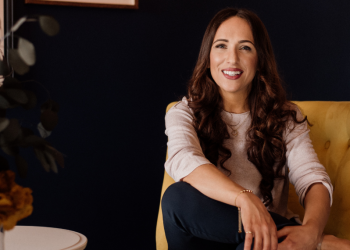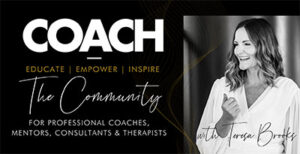The Secret to a Thriving Creative Business – Miriam Schulman

The Secret Behind Building a Sustainable Creative Business
Today, when I tell people that I worked in finance, they all say the same thing, “You must have hated that.” They can’t reconcile the hippy-dippy artist they see now with the image of a suited-up banker. However, before I became a full-time artist, I had a whole other life and I understand how it feels to be tied to a job. I wanted to be an artist, but my Jewish mother feared I’d never make any money—and I believed her. She expected me to become a doctor, a doctor’s wife, or a disappointment. Not wanting to disappoint my family, I took the practical route with a high-paying job on Wall Street.
Why Some Businesses Succeed
However, after the 9/11 terrorist attacks, I had a wake-up call and took that as a sign from the Universe to follow a different path. At this time, I was painting on the side, but I hadn’t (yet) gone all-in on an art career. I sold a painting here and there at local art fairs and also started painting my first portraits. Since I didn’t want to go back to a corporate job, I started teaching Pilates at a big chain of gyms in the New York metropolitan area. The business model of most gyms relies not only on memberships but also on upselling personal training packages to their clients. As a result, this gym chain spent a lot of time training new recruits in selling fundamentals.
During our mandatory sales training day, I filled up several pages on a yellow legal pad. The gym’s most popular instructors suggested we add personal touches, whether it was cards, gifts, or little bonuses, to keep customers coming back for more. They reviewed the anatomy of the sale, how to nurture client relationships, and the value of referrals. Fired up from a day of exercise and motivational talks, I hatched a plan to hook my next sale—but not for the gym. If I intended to turn my energy towards marketing, I wanted my efforts to fuel my passion for art, not personal training packages.
When I started applying traditional sales and marketing principles to my art business thrived and while it didn’t happen overnight, I finally became my own “art” boss. Fast forward some twenty years, I run a multiple 6-figure art business and coach other emerging artists. In addition, I’m the host of The Inspiration Place podcast, which ranks in the top 1% of podcasts globally.

Build A Thriving Business You Can Be Proud Of
Beyond my art, my specialty is coaching other artists and creatives on how to take their talent and create a thriving business out of it. To this day, I still use the traditional marketing skills that don’t rely on social media fads that I learned all those years ago and continue to hone. They’re the foundations that I use to sell my art and the same techniques that I teach to my clients. It’s possible for anyone to profit from a creative business using traditional marketing and business principles.
Here’s the 5 Foundations for Prosperous Entrepreneurship:
Which ones do you need to work on?
Production Plan: Build a body of work.
You have to have marketable assets to sell which you can produce on a consistent basis. If your product takes too long to produce then your capacity will limit your success. For example, tf you want to make $60K a year as an artist, you’ll need to produce 1-2 new products each week that can sell at $1K each ready to go out the door. That’s why it’s very difficult to make a sustainable living selling handknit sweaters that may take a month to create.
As part of the production plan, you also have to consider if your art can be priced higher. For example, I once worked with an artist who was having trouble making money selling greeting cards. She had them priced at just $10 each. Her problem wasn’t finding customers, but that the product couldn’t be priced higher. She thought she needed a larger audience but when I showed her that she needed to find 5,000 customers to make a sustainable living selling handmade greeting cards she understood the math didn’t work. Instead of looking for more customers, she started selling the same art on canvas and her profits soared.
Pricing Plan: Price for profit.
When business owners have a production problem, the math doesn’t work because they are limited by the kind of products they create or by their capacity to produce. When they have a pricing problem, they could be pricing their art higher but aren’t because their mind drama gets in their way. They think collectors are motivated by lower prices and will sell more at a lower price, but that’s almost never the case. Most people are so married to the sabotaging stories they tell themselves that they can’t recognize these thought patterns as low-profit thinking. Pricing anything too low will lead your customers to question its value and authenticity. You might think people aren’t buying from you because your prices are too high, but the problem could be that your prices are too low!
Start charging premium market value for your products.
Prospecting Plan: Find your audience.
Prospecting is the first step in the sales process and is critical to building any successful business. Successful creatives understand that they need to go out and find people who love their art and then create a plan so that they can contact them in the future. This is prospecting. The mistake many creatives make is that they meet prospects but don’t add them to their email list. Either they hand them a business card or hope the prospects will find them again on social media.
Creatives who solely focus only on building a social media following without a reliable way to stay in touch will fail to make consistent revenue from their audience. Facebook and Instagram accounts are shut down all the time with thousands of followers (and all your online content) vanishing in the blink of an eye. Don’t think it can’t happen to you because you “follow the rules.” My Instagram account got hacked, and it took me over a month to convince Facebook (Instagram’s parent company) that I was the true owner of the account. One of my clients had her Instagram account shut down without providing a reason after she posted an artwork of a bird.
There’s no reliable help desk for this behemoth of a company and she’s left scratching her head wondering what happened and why. Other well-known influencers with hundreds of thousands of followers have also seen their accounts shut down or hacked. For example, Jessy Taylor called the police after Instagram removed her account of more than 100,000 followers because she said, “It felt like murder.” Without another way of reaching her fan base, she was unable to retain her business, and she struggled to rebuild her following and business after her account was shut down.
Promotion Plan: Close sales
The fourth part of the framework is the promotion plan, which includes your sales and marketing plans. Many business owners confuse marketing and sales because they try to combine the two and both marketing and sales involve forms of promotion. Here’s how they differ. Marketing promotions get the attention of your prospects and convert them into email subscribers. Sales are what you do when you’re talking to someone who has some awareness of you and is ready to buy. Sales promotions are the words on your website, and what you say in emails (or in-person) to close the sale.
Productivity Plan: Create systems to organize your business.
Once you’ve learned all the steps of prospecting and promoting, how do you organize all of this, so you can focus and stop spinning? Technology does help us become more productive through automation, but that’s usually only a small piece of this puzzle. Your productivity plan includes all the steps you take from the time you meet a prospect until they finally buy from you and all the steps that happen in between. Your productivity plan is how you organize yourself so you manage your priorities, protect your sacred studio time, and stay focused on your goals.
To make a sustainable living with a creative business, you need to become a ninja about managing your priorities and how you spend your days. I use both a digital and an analog calendar to plan my time and manage what I’m doing each day to keep my activities focused on my goals.
Clients who come to work with me want to learn the secret behind selling boldly. Many creatives I speak to believe they lack confidence because of their poor results. They think that if they had better results, such as more sales, they would get more confidence. Others believe that the reason they’re procrastinating and not focusing is due to the same lack of confidence. They don’t yet know the secret to unlock greater confidence lies in your ability to learn to trust yourself, and that starts with following through on your own commitments. You may not always be in control of your results, but you’re always in control of the actions you take. When you focus on building these five foundations for your business, you’ll spend less time spinning and your confidence and business will thrive.
Miriam Schulman is an artist, author, and founder of The Inspiration Place and The Artists Incubator Coaching Program where she helps artists (from amateurs to professionals) develop their skills, tap into their creativity, and grow thriving art businesses. Her podcast, The Inspiration Place, is in the top 1% of all podcasts globally and is listened to in over 40 countries. Visit schulmanart.com/profit to get your free e-book copy of The Artist’s Profit Plan to learn more about developing a solid foundation for a creative business.




